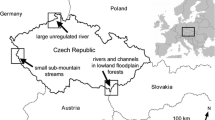Abstract
Space use by animals has been studied for decades; however, gaps still exist in the understanding of how it is affected by biological and environmental factors. The aim of this study was to determine how biological traits, population parameters and seasonal variations affect the use of space by rodents in a tropical savannah environment. This study was performed in two grids in a grassland area at Aguas Emendadas Ecological Station between January 2004 and December 2013. The trapping sessions lasted six consecutive days and were performed monthly. Sherman traps, which were baited and reset daily, were used to capture the animals. The movement area was estimated using the minimum convex polygon method, and the mean movement distance was used to investigate the factors that affect the movement of the rodents. The hypothesis that a significant difference exists in the movement area size among species was corroborated; however, this difference was not related to body weight. As a general pattern for these rodents, males displayed larger movement areas than females. Movement area size showed an inverse relationship to population density. The understanding of the factors that affect the space use by rodents are complex and the interactions of these factors may also modulate space use by rodents. Our results suggest that space use is also affected by climatic variations.
Similar content being viewed by others
References
Alho, C.J.R., Souza, M.J., 1982. Home range and use of space in Zygodontomys lasiurus (Cricetidae, Rodentia) in the central Brazil. Ann. Carnegie Mus. 51, 127–132.
Ambrose, H.W., 1973. An experimental study of some factors affecting the spatial and temporal activity of Microtus pennsylvanicus. J. Mammal. 54, 79–110.
Börger, L., Franconi, N., Ferretti, F., Meschi, F., De Michele, G., Gantz, A., Coulson, T., 2006. An integrated approach to identify spatiotemporal and individual-level determinants of animal home range size. Am. Nat. 168, 471–485.
Belcher, C.A., Darrant, J.P., 2004. Home range and spatial organization of the marsupial carnivore, Dasyurus maculatus (Marsupialia: Dasyuridae) in south-eastern Australia. J. Zool. 262, 271–280.
Burt, W.H., 1943. Territoriality and home range concepts as applied to mammals. J. Mammal. 24, 346–352.
Cáceres, N.C., Graipel, M.E., Monteiro-Filho, E.L.A., 2010. Técnicas de observacão e amostragem de marsupiais. In: Reis, N.R., Peracchi, A.L., Rossaneis, B.K., Fregonezi, M.N. (Eds.), Técnicas de estudos aplicadas aos mamíferos silvestres brasileiros. Technical Books Editora, Rio de Janeiro, pp. 21–36.
Cardoso, M.R.D., Marcuzzo, F.F.N., Barros, J.R., 2015. Classificacão Climática de Köppen-Geiger para o Estado de Goiás e o Distrito Federal. Acta Geogr. 8, 40–55.
Crawley, M.J., 2007. The R Book. Wiley, Chichester, UK.
Damuth, J., 1981. Population density and body size in mammals. Nature 290, 699–700.
Erlinge, S., Hoogenboom, I., Agrell, J., Nelson, J., Sandell, M., 1990. Density-related home-range size and overlap in adult field voles (Microtus agrestis) in Southern Sweden. J. Mammal. 71, 597–603.
Fernandes, F.R., Cruz, L.D., Martins, E.G., dos Reis, S.F., 2010. Growth and home range size of the gracile mouse opossum Gracilinanus microtarsus (Marsupialia: Didelphidae) in Brazilian cerrado.J. Trop. Ecol. 26, 185–192.
Gaulin, S.J., FitzGerald, R.W., 1986. Sex differences in spatial ability: an evolutionary hypothesis and test. Am. Nat, 74–88.
Getz, L.L., McGuire, B., 2008. Factors influencing movement distances and home ranges of the short-tailed shrew (Blarina brevicauda). Northeast. Nat., 293–302.
Getz, L.L., Oli, M.K., Hofmann, J.E., McGuire, B., Ozgul, A., 2005. Factors influencing movement distances of two species of sympatric voles. J. Mammal. 86, 647–654.
Gomez, D., Sommaro, L., Steinmann, A., Chiappero, M., Priotto, J., 2011. Movement distances of two species of sympatric rodents in linear habitats of Central Argentine agro-ecosystems. Mamm. Biol. 76, 58–63.
Heiberger, R.M., 2015. In: Heiberger, Holland (Eds.), Statistical Analysis and Data Display. R Package Version 2, pp. 1–32.
Jennrich, R., Turner, F., 1969. Measurement of non-circular home range. J. Theor. Biol. 22, 227–237.
Kenward, R.E., Walls, S.S., South, A.B., Casey, N.M., 2008. Ranges8: Forthe Analysis of Tracking and Location Data. Anatrack Ltd., Wareham, UK.
Lindstedt, S.L., Miller, B.J., Buskirk, S.W., 1986. Home range, time, and body size in mammals. Ecology 67, 413–418.
Loretto, D., Vieira, M.V., 2005. The effects of reproductive and climatic seasons on movements in the black-eared opossum (Didelphis aurita Wied-Neuwied, 1826). J. Mammal. 86, 287–293.
Múrua, R., Gonzales, LA., Meserve, P.L., 1986. Population ecology of Oryzomys longicaudatus philippii (Rodentia: Cricetidae) in southern Chile. J. Anim. Ecol. 55, 281–293.
Magnusson, W.E., De Lima Francisco, A., Sanaiotti, T.M., 1995. Home-range size and territoriality in Bolomys lasiurus (Rodentia: Muridae) in an Amazonian savanna. J. Trop. Ecol. 11, 179–188.
Makarieva, A.M., Gorshkov, V.G., Li, B.L., 2005. Why do population density and inverse home range scale differently with body size? Implications for ecosystem stability. Ecol. Complex. 2, 259–271.
Mares, M.A., Adams, R., Lacher Jr., T.E., Willig, M.R., 1980. Home range dynamics in chipmunks: responses to experimental manipulation of population density and distribution. Ann. Carnegie Mus. 4913, 193–201.
Mitchell, M.S., Powell, R.A., 2004. A mechanistic home range model for optimal use of spatially distributed resources. Ecol. Model. 177, 209–232.
Moorcroft, P.R., 2012. Mechanistic approaches to understanding and predicting mammalian space use: recent advances, future directions. J. Mammal. 93, 903–916.
O’Farrell, M.J., 1974. Seasonal activity patterns of rodents in a Sagebrush Community. J. Mammal. 55, 809–823.
Oliveira, CM., Frizzas, M.R., 2008. Insetos do Cerrado: distribuicão estacional e abundância. Boletim de Pesquisa e Desenvolvimento. Embrapa—CPAC, Planaltina, Brasil.
Oliveira-Filho, A.T., Ratter, J.A., 2002. In: Oliveira, P.S., Marquis, R.J. (Eds.), Vegetation Physiognomies and Woody Flora of the Cerrado Biome. The Cerrado of Brazil Editora Columbia University, Nova Iorque, USA, pp. 91–119.
Ostfeld, R.S., 1985. Limiting resources and territoriality in microtine rodents. Am. Nat. 126, 1–15.
Perry, G., Garland, T., 2002. Lizard home ranges revisited: effects of sex, body size, diet, habitat, and phylogeny. Ecology 83, 1870–1885.
Pinheiro, F., Diniz, I., Coelho, D., Bandeira, M., 2002. Seasonal pattern of insect abundance in the Brazilian cerrado. Austral Ecol. 27, 132–136.
Pinheiro, J., Bates, D., Debroy, S., 2011. R Package. nlme: Linear and Nonlinear Mixed Effects Models, 3 ed. Deepayan Sarkarand R Development Core Team.
Pires, A.d.S., Fernandez, FAd.S., Feliciano, B.R., Freitas, D.d., 2010. Use of space by Necromys lasiurus (Rodentia, Sigmodontinae) in a grassland among Atlantic Forest fragments. Mamm. Biol. 75, 270–276.
Powell, R.A., Mitchell, M.S., 2012. What is a home range. J. Mammal. 93, 948–958.
Price, M.V., Waser, N.M., Bass, T.A., 1984. Effects of moonlight on microhabitat use by desert rodents. J. Mammal. 65, 353–356.
Priotto, J., Steinmann, A., Polop, J., 2002. Factors affecting home range size and overlap in Calomys venustus (Muridae: Sigmodontinae) in Argentine agroecosystems. Mamm. Biol. 67, 97–104.
Proenca, C., Oliveira, R.S., Silva, A.P., 2000. Flores e frutos do Cerrado. Universidade de Brasília, São Paulo, Brasil.
Ribeiro, R., Marinho-Filho, J., 2005. Estrutura da comunidade de pequenos mamíferos (Mammalia, Rodentia) da Estacão Ecológica de Águas Emendadas, Planaltina, Distrito Federal, Brasil. Rev. Bras. Zool. 22, 898–907.
Ribeiro, J.F., Walter, B.M.T., 2001. As matas de galeria no contexto do bioma Cerrado. In: Ribeiro, J.F., Fonseca, C.E.L., Sousa-Silva, J.C. (Eds.), Cerrado: caracterizacão e recuperacão de matas de galeria. EMBRAPA, Planaltina, Brasil, pp. 29–47.
Ribeiro, R., Rocha, C., Marinho-Filho, J., 2011. Natural history and demography of Thalpomys lasiotis (Thomas, 1916), a rare and endemic species from the Brazilian savanna. Acta Theriol. 56, 275–282.
Rocha, C.R., Ribeiro, R., Takahashi, F.S.C., Marinho-Filho, J., 2011. Microhabitat use by rodent species in a central Brazilian cerrado. Mamm. Biol. 76, 651–653.
Sano, S.M., Almeida, S.P., 1998. Cerrado: ambiente e flora. EMBRAPA-CPAC, Planaltina, Brasil.
Schoener, T.W., 1968. Sizes of feeding territories among birds. Ecology 49, 123–141.
Sikes, R.S., Gannon, W.L., 2011. Guidelines of the American Society of Mammalogists for the use of wild mammals in research. J. Mammal. 92, 235–253.
Silva, NAP. d., Frizzas, M.R., Oliveira, C.M.d., 2011. Seasonality in insect abundance in the Cerrado of Goiás State, Brazil. Rev. Bras. Entomol. 55, 79–87.
Slade, N.A., Russell, L.A., 1998. Distances as indices to movements and home-range size from trapping records of small mammals. J. Mammal. 79, 346–351.
Spencer, W.D., 2012. Home ranges and the value of spatial information. J. Mammal. 93, 929–947.
Swihart, R.K., Slade, N.A., Bergstrom, B.J., 1988. Relating body size to the rate of home range use in mammals. Ecology 69, 393–399.
Vieira, E.M., Baumgarten, L.C., 1995. Daily activity patterns of small mammals in a cerrado area from central Brazil. J. Trop. Ecol. 11, 255–262.
Vieira, E., Baumgarten, L., Paise, G., Becker, R., 2010. Seasonal patterns and influence of temperature on the daily activity of the diurnal neotropical rodent Necromys lasiurus. Can. J. Zool. 88, 259–265.
Wolff, J.O., Edge, W.D., Bentley, R., 1994. Reproductive and behavioral biology of the gray-tailed vole. J. Mammal. 75, 873–879.
Wolff, J.O., 1993. Why area female small mammals territorial? Oikos 68, 6.
Zuur, A., Ieno, E., Walker, N., Saveliev, A., Smith, G., 2009. Mixed Effects Models and Extensions in Ecology with R. Springer, New York, USA.
Author information
Authors and Affiliations
Corresponding author
Rights and permissions
About this article
Cite this article
Rocha, C.R., Ribeiro, R. & Marinho-Filho, J. Seasonal variations and population parameters explaining the use of space of neotropical rodents. Mamm Biol 81, 551–557 (2016). https://doi.org/10.1016/j.mambio.2016.07.043
Received:
Accepted:
Published:
Issue Date:
DOI: https://doi.org/10.1016/j.mambio.2016.07.043




